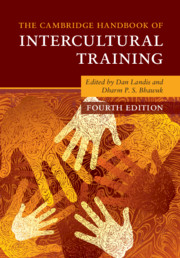Book contents
- The Cambridge Handbook of Intercultural Training
- Reviews
- The Cambridge Handbook of Intercultural Training
- Copyright page
- Dedication
- Frontispiece
- Contents
- Figures
- Tables
- Editors and Contributors
- Foreword
- Preface
- 1 Introduction and Theoretical Framework
- Part I Theoretical Foundations of Intercultural Training
- Part II Practice of Intercultural Training
- 10 International Initiatives in K–12 and Higher Education
- 11 The Triad Training Model in Counseling, Cultural Diversity, and Intercultural Training
- 12 Multicultural Counseling Training and Intercultural Training
- 13 Training for Cross-Cultural Competence in the United States Military
- 14 Developing Intercultural Competency Training in Global Organizations
- Part III Indigenous Psychology and Intercultural Training
- Part IV New Interdisciplinary Approaches to Intercultural Training
- Part V Summing Up
- Index
- References
11 - The Triad Training Model in Counseling, Cultural Diversity, and Intercultural Training
from Part II - Practice of Intercultural Training
Published online by Cambridge University Press: 18 September 2020
- The Cambridge Handbook of Intercultural Training
- Reviews
- The Cambridge Handbook of Intercultural Training
- Copyright page
- Dedication
- Frontispiece
- Contents
- Figures
- Tables
- Editors and Contributors
- Foreword
- Preface
- 1 Introduction and Theoretical Framework
- Part I Theoretical Foundations of Intercultural Training
- Part II Practice of Intercultural Training
- 10 International Initiatives in K–12 and Higher Education
- 11 The Triad Training Model in Counseling, Cultural Diversity, and Intercultural Training
- 12 Multicultural Counseling Training and Intercultural Training
- 13 Training for Cross-Cultural Competence in the United States Military
- 14 Developing Intercultural Competency Training in Global Organizations
- Part III Indigenous Psychology and Intercultural Training
- Part IV New Interdisciplinary Approaches to Intercultural Training
- Part V Summing Up
- Index
- References
Summary
This chapter describes Paul Pedersen’s Triad Training Model, which is a unique experiential activity originally designed for counselors-in-training to help them better understand culturally different others. While it is a versatile tool that can be effective in other types of training situations, it is not well-known outside the field of multicultural counseling. While many popular intercultural simulations target cultural awareness, the Triad Training model is more holistic in that it is able to simultaneously raise awareness, impart cultural knowledge, address emotional issues, and help participants develop skills. This chapter begins by explaining the cultural context that gave birth to the model as well as its research foundation in psychology. Next, it examines its goals as well as how it evolved during the forty years since its creation. Finally, because the model is confrontational in its approach, the author shows how she adapted it for collectivist cultures.
Keywords
- Type
- Chapter
- Information
- The Cambridge Handbook of Intercultural Training , pp. 377 - 406Publisher: Cambridge University PressPrint publication year: 2020



